Culture of Crete
We, Cretans, are permanently in love with our island
We, Cretans, are permanently in love with our island and what it stands for. We are in love with its spirit which evolved from vivacious Minoan times through perpetual and eventful contacts with different races and civilizations, the Dorians, the Egyptians, the Byzantines, the Arabs, the Venetians, the Turks... This very special spirit transcends the limits of culture; we have learnt to distinguish it in all aspects of our life. It runs through the "rizitika" folk songs; it resides in plant motifs of ancient earthenware; it characterizes the way a shepherd drives its flock of sheep to the slopes of the Sfakian mountains; it is diffused in the aroma of "diktamos" herb and adds fire to the eyes of a solitary priest saying mass at a small country church, a handgun passed in his belt...
There are hundreds of cafes where one sits in the shade of a spreading plane, oak, tamarisk or mulberry tree and sips a ''sweat'' or ''medium'' coffee, or a glass of ''tsikoudia'' (raki) while playing a game of cards or ''tavli'' (backgammon). There are dozens of tavernas and ouzeries serving some tasty ''meze'', a specialty of the area. Yogurt and honey, sweet tarts (kaltzounia), pies made of wild greens flavored with fennel, fried cheese (staka), rabbit stew, cheese pie from Chora Sfakion, cockles, boiled goat. In the city of Chania, at Malaxa, at Vrisses, and other villages in the area of Rethimno, in Iraklio and its villages and in the whole district of Lassithi. Fish, sea urchins, octopus and cuttlefish cooked on coal and fried squid to be tasted at seaside tavernas. And everywhere the delectable Cretan wine. Every saint's feastday is celebrated with gusto at dozens of villages throughout the island; all Crete throbbing to the sound of the Cretan lyre and the rhythm of the local dances, the pentozali and the sousta. Meanwhile the housewives are preparing a steamed Cretan pilaf and special holiday fritters (xerotigana). In the shop windows of bustling Iraklio, picturesque Rethimno, and Chania, precious jewelry and artist silverware attract the visitor's attention. In the shops of lovely Sitia and tranquil Ierapetra and in mountainous Anogia one is impressed by the spread out ''patanies'', traditional local woven fabrics in dazzling colors, and everywhere one sees skillfully crafted ceramics and leather goods.
Famous Cretans
NIKOLAOS KAZANTZAKIS
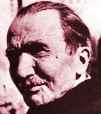
Nikos Kazantzakis
Nikos Kazantzakis is the most written about and translated Greek author, internationally acclaimed as being among the classical writers of all time.
He was born on 18th February 1883 in the town of Heraklion in Turkish-held Crete during the fierce Cretan uprising to shake off the Turkish occupiers and regain their freedom. His father, Capetan Michalis, was among the battle leaders, which affected him in his early childhood with the experiences of morality and living history that is reflected in his writing. His mother, Maria Christodoulaki, came from the village of Asyroti, now known as Krioneri (Coldwater). His father was from the village of Varvari, also named Myrtia.
The first stages of his education were obtained in schools in Heraklion and Naxos. From 1902 – 06 he attended Athens University, where he received a first class degree in Law. Immediately after his graduation he was published, under the pseudonym of Karma Nirvami, in the ‘Letters’ with his essay ‘The Sickness of the Age’, the drama ‘Day is Breaking’ and the novel ‘Serpent and Lily’. From the beginning, his articles left a lasting impression. He used the pseudonyms of: Karma Nirvami, Petros Psiloritis and Akritas, when he emerged as a correspondent in the press of the day with his varied compositions.
In 1908 – 09, he went to Paris extend his studies, where the French philosopher, Henri Bergson left a lasting impression.
From 1910 he lived in Athens where he concentrated on his writing with some scholarly and philosophical translations of works of intellectual world repute as well as Greek classical works such as those of Plato and others. Much later, he would translate Homer’s ‘Iliad’ and the ‘Odyssey’ with Yiannis Kakridis and alone he translated plays of other foreign writers.
In 1911, he married his childhood sweetheart, Galateia Alexiou, but as they were not compatible they separated very quickly and were later divorced.
The following year he volunteered for service in the Balkan Wars, at this time Cretans were still under the Ottoman Empire rule. He met the poet, Angelos Sikelianos in 1914. They stayed at the Aghion Oros (Mount Athos), for forty days then travelled the length and breadth of Greece on a philosophical journey seeking an awareness of the earth with the soul. The two friends repeated this journey in later years. The author wrote that these journeys and his dreams were beneficial and food for his soul.
With some articles, translations and business ventures he tried to sustain a living, from which the best resulted in his meeting with George Zorba, whom he immortalized as Alexis Zorba in his later novel.
From 1917 onwards,
he extended his travelling to places outside Greece with the first
being Switzerland. There he came into contact
with the works of Nietzsche, this writer strongly influenced and
deeply moved him with his brave dogma and, added to exulted teachings
of Homer, Dante and Bergson, became part of the later ‘guru’ character
of Zorba.
The great turning point in his early career was his appointment as
General Director of the new Ministry of Public Welfare, in 1919 by
Eleftherios Venizelos, responsible for the Greek refugees expelled
from Caucasus after the installation of the Communist regime in the
Soviet Union. 150,000 refuges were repatriated and established in
the regions of Macedonia and Thrace. This gigantic task required
a national perspective and the inspiration of a prophet for its successful
conclusion.
Despite the significantly long tours of Greece and his productive
occupations, he does not stop writing indicated by his thesis “Friedrich
Nietzsche on the Philosophy of Law and Society” (1909) and
the tragedy “The Master Builder” (1910), which was first
staged at the Municipal Theatre of Athens in 1916. Everywhere, he
sought the essence from under the phenomena of conventionality to
reveal the soul and the truth from which he had been pre-conditioned.
In 1921, he visited Germany, Austria and Italy, but always returning to Crete. He visited Messolongi as well as other historical civilizations the following year. His perpetual returns to Crete gave him the drive and strength to continue.
The following year, 1922, found him in Vienna and Berlin where its strong public unrest, radical ideological probing and the new classification deeply affected him. Added to which, during the same year, the catastrophe faced by the Greek population of Asia Minor brought a sudden change in the spiritual theories of the great analyst. At that time he met with the ladies of the ‘fire circle’ of Berlin, which affected his life and works. It was then that he wrote “Askitiki”, “The bible, according to Kazantzakis”, as described by a Swiss newspaper.
In 1923 and 1924 he travelled in Germany and Italy. For 40 days he stayed in Assisi, the town of St Francis of whom he based his later work “God’s Pauper”.
The date of 18th May 1924 was to prove of vast significance to him,
as this was the day he met Eleni Samiou, who became his ideal companion
and wife until he died.
He described Eleni as his “seven-woman, seven-skinned pole
of his life”, “To Eleni I owe all of my daily happiness
throughout my life, without her I would have died long ago. My companion,
brave, dedicated, proud and ready for every action that needs love”,
he wrote in May 1957 five days before he died.
He continued his travels around Greece and in 1925-26 visited the Soviet Union, then Cyprus, Palestine, Libya, Spain, Italy, Egypt and Sinai until the beginning of the following year. In the summer of 1927 he published “Askitiki” in a magazine; he later embellished and corrected it. He completed “The Odyssey” that was not published until 1938. In the same year he went to Moscow and met Panait Istrati. Toured the country as far as the Caucasus during which he sent travelogues to Athens, as he did during all his later journeys.
In 1928, he is based in Aegena and again travels to Russia, touring most of the country. The following year he visits Czechoslovakia where he writes “Toda-Raba” and in 1930 he is in Paris. The next year he returns to Crete as well as revisiting Paris, Czechoslovakia and Aegena. The same year, 1932, his parents died and for consolation immersed himself in travelling and writing, touring Spain returning to Aegena via Paris.
In 1935, he travelled to China and Japan. The travelogue of this journey was published the same year as were for the other countries he visited: England, Spain, Russia, Italy, Egypt, Cyprus and Palestine. He then returned to Aegena in 1936 setting up home with Eleni. There they built their castle-like home, as it was described by the author.
The same year the Nazi regime banned the issue and circulation of his novel “The Rock Garden”. At this time he translated “Faust” by Goethe and wrote some plays among which was “Othello Returns”.
Towards the end of 1936, found him again in Spain, which engulfed in a bitter civil war. His shocking reports of the fighting were published in the “Kathimerini”. He found inner peace on his return to Aegena then travelled around Greece the following year, which coincided with the publication of his books.
His great work “Odyssey” was published in 1938. Following his death this work was translated in to English by Kimon Friar and became a ‘best seller’ in England and America. This work was categorized as an epoch of the white race and a spiritual monument of the century.
He was in England when the first bombs of World War II fell on a meaningful exploration of the soul, returning to Aegena and Crete the following year. The German occupation of Greece in 1941 restrained his movements. During this time Kazantzakis draws subjects from Greek history and writes the works: “Alexander The Great”, “At the Palaces of Knossos”, the trilogy of Prometheus – “Capodistria”, “Constantine Palaeologos”, translates Homer’s “Odyssey” and “Iliad”. He also wrote “Zorba the Greek” on learning of the death of his friend.
On the liberation of the country from the occupying German forces he became involved in politics again and was appointed Minister without Portfolio in the Sofoulis Government (November 1945), but he resigned after only one and half months. Earlier in the same year he was refused as a member of the Order of Literature and the Arts of the Academy of Athens.
In 1945, he was sent to Crete as a Committee Inspector to ascertain the atrocities committed by the German and Italian occupying forces on the island.
The following year he revisited England. He was very active in his attempts to motivate the scholars of the world for peace and culture in the establishment of UNESCO. At that time the subject of the Nobel Prize surfaced. For 10 years he actively pursued it and it appears that there was a consensus of support for him to win, throughout this time his home country challenged him getting the prize.
From 1946 he is driven away from his homeland by persecution, but his heart always belonged to Greece.
During those years from the end of the 40’s and the 50’s he wrote the novels: ‘Christ Recrucified’, ‘The Fratricides’, ‘Freedom and Death’, ‘The Last Temptation of Christ’, ‘God’s Pauper’ and ‘Report to Greco’. He was based in France and travelled to the surrounding countries, but health begins to fail him.
The Greek Orthodox
Church demands the removal of some pages of his novel ‘Freedom and Death’ and the complete withdrawal
of ‘The Last Temptation of Christ’ although the novel
had not been published in Greek. At this time the Vatican placed
the same book in their ‘Index’ of banned books.
Kazantzakis protested to the Index Committee by telephone saying “I
am appealing to your Courts, Lord.” The matter in question
is the quote by Tertillianos “Ad tuum, Domine, tribunal apello”.
The same appeal was presented to the Church of Greece with the addition
of “To your Courts, Lord, I make my appeal. For our Archbishops
and Bishops I add this: You gave me a curse, Holy Fathers, I give
you a blessing: I wish that your consciences are as clean as is mine
and that you are as righteous and religious as I am.”
The Vatican Index of banned books was later withdrawn and in 1968 the Ecumenical Patriarch Athinagoras of the Greek Church said that the books of Nikos Kazantzakis have been placed in the Patriarchal Library.
In 1957, Nikos and Eleni Kazantzakis experience great joy with the making of the film, ‘Christ Recrucified’ directed by Jules Dassin. They attend its premiere in Cannes. In June of the same year, they travel to China and Japan again. He was vaccinated in Canton, which caused his arm to swell. On his return he entered the National Hospital of Copenhagen for treatment and was then transferred to the University Clinic of Freiburg in West Germany. He recovered from this illness, but in his weakened state succumbs to the then fatal strain of Asian flu.
On 26th October 1957 the great hermit spirit departs at the age of 74 years. His remains arrived in Athens on 3rd November and were transferred by air to Heraklion on 4th November where he lay in state for the people to pay their respects to the great Cretan author. His funereal took place in Heraklion cathedral on 5th November 1957 and he was buried on the Martinego Bastion of the Venetian Walls surrounding the town of Heraklion.
His tomb became the spiritual global memorial to the man and a breath of fresh air to the universe holding the spirit of the world alive.
Source: Museum Nikos Kazantzakis
...Crete's
Mystery is deep. Whoever sets foot on the island senses a
mysterious force branching warmly and beneficently through
his veins, senses his soul begin to grow...
...There is a kind of flame in Crete - let us call it "soul"
- something more powerful than either life or death. There
is pride, obstinacy, valor, and together with these something
else, inexpressible and imponderable, something which makes
you rejoice that you are a human being, and at the same time
tremble...
...Here in Crete the monstrous immovable statues of Egypt
and Assyria became small and graceful, with bodies that moved,
mouths that smiled. The features and stature of God took on
the features and stature of man. A new, original humanity
full of agility, grace and oriental luxury lived and played
in the Cretan soil...
Nikos Kazantzakis
VICENZOS KORNAROS
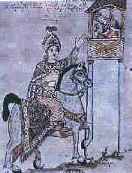
Erotokritos
Although there is no definite information about Vicenzos Kornaros, it is known that he lived in Sitia and Heraklio in the 17th century and died in 1677. Kornaros is said to have written the famous cretan work of literature "Erotokritos". This terrific narrative piece was written in 10,000 15-syllable verses. There is only one remaining copy, dated back in 1710. The work was first published in Venice, in 1713. Even though the plot is trivial, it is said that Kornaros was inspired by the french medieval play "Paris et Vienne", which he turned in a literal masterpiece.
Due to its music and lyrics, Erotokritos is still being sung nowadays. The names of the heroes, Erotokritos and Aretoussa, can still be found in Crete these days. Kornaros is said to have written the poetic drama "Abraham's Sacrifice" which consisted of 1,154 15-syllable verses and was first published in 1635. His ideal was the tragedy "Isaac", by the Italian L. Grotto.
Of
all the gracious things upon this earth
It is fair words that have the greatest worth,
And he who uses them with charm and guile
Can cozen human eyes to weep or smile.
-- V. Kornaros, Erotokritos I 887-90 (Stephanides)
Begin
your lesson now. It is a rule
That he who starts in time soon leaves the school.
-- V. Kornaros, Erotokritos II 1871-2 (Stephanides)
There
are full many, sweet, whose tongues are bland,
Who hide a poison phial in the hand.
-- V. Kornaros, Erotokritos III 141-2 (Stephanides)
>English translation of Erotokritos by Theodore Ph. Stephanides, published by Papazissis, Athens, 1984.
DOMENIKOS THEOTOKOPOULOS (El Greco)
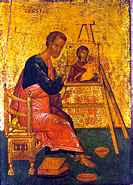
El Greco
Domenicos Theotokopoulos was born in Heraklio, in 1541. He was first taught hagiography at a venetian workshop and was influenced by the Cretan Hagiographic School (16th century) and the byzantine art. El Greco was trained as an icon painter on his native island of Crete, then a territory of the Venetian Republic. A young man of enormous talent and ambition, he left Crete around 1568 for Italy, where he learned the grand manner of Italian painting. In 1577, unable to achieve the success he desired in the highly competitive art world of Venice and Rome, El Greco, now thirty-six years old, departed for Spain, where he spent the remainder of a long and productive career in the city of Toledo. He was patronized there by members of the city's wealthy and educated elite who valued the presence of an intellectual artist who had been trained in Italy. He spent most of his life in Toledo, Spain, where he died in 1614. El Greco, as he was called, occupied with sculpture and architecture, although the only samples of his work are the sculpt icon- stands in Santo Domingo el Antiguo (1577), the chapel of San Jose in Toledo (1597-1599) and the church of Mercy Hospital in Ilieskas (1603 - 1605). El Greco's painting follows the four cities where he lived: Heraklio, Venice, Rome and Toledo. The most known of his work are: "Boy blowing the coal", "Holy Trinity", "St. John Baptist", "Merciful Virgin Mary", "The "Ascension of Virgin Mary" and others.
ELEFTHERIOS VENIZELOS
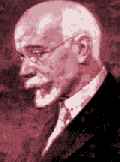
Eleftherios Venizelos
Eleftherios Venizelos was born in Mournies in the prefecture of Chania, in 1864. His family came from Sparti and came to the island when Benizelo Krevatas moved here in 1790 and gave his name to the famous family of Venizelos. Eleftherios had a difficult childhood, as the revolution forced his father to leave the island and move to Syros, where the young boy had his first education. After a PhD in Law, he left Athens in 1886 to return to his home-town. He soon was involved in politics and was elected congressman at the Cretan Council; he later became Minister of Justice. In 1905 he was the leader of United Opposition Party, while in 1908 he was again appointed Minister of Justice and Foreign Affairs. After his intervention in the negotiations between the "rebels", the Crown and the Political Parties, he was elected "President of the Greek Council of the Cretans" and Prime Minister of Crete, in 1910. Within the next months he became the leader of the Liberal Party, won the elections of the Revisory Parliament (December 1910) and thrived at the next elections (March 1912). In 1916, he established at Chania - along with Daglis and Koundouriotis - the National Triumvirate, forming a temporary government of National Defence. He lost the elections of 1920 and went abroad. In 1923, Venizelos represented Greece at the Treaty of Lozanne, signing the treaty of exchanging populations. Later in that year, he came back to Greece and became governor, only to quit within a short period of time. In the following years, Venizelos was on and off the government until he lost the elections of 1933. Later that year, someone attempted to murder him at Kifissias Ave. Venizelos died in Paris, in March 1936. He was buried at Akrotiri Chanion, in the area of Profitis Ilias.
DASKALOGIANNIS
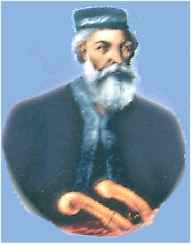
Daskalogiannis
Daskalo Gianni ("Giannis The Teacher"), was one of the many leaders in the Cretan aspect of the rebellion. He was born in Anopoli, the village on the hill top above Chora Sfakion. At the end of the Turkish occupation (1669 - 1898) in 1770 the Turks had offered a settlement to the Cretans where there would be no more deaths. Daskalo Gianni, knowing full well he was walking into a trap, went to meet the Turkish leaders. He hoped that something could be resolved, or at the very least, his death could provide a pivotal point of inspiration for the liberation of Crete. Needless to say, the Turks brutally tortured him and beat him in an attempt to extract strategic information from him. Even after they skinned him alive, he would still not betray his people to the barbaric enemy. He died of his injuries quickly. These were followed by riots which led to the declaration of Crete as an independent "Cretan State" in 1898.
NIKOS XYLOURIS
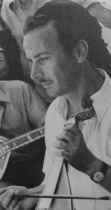
Nikos Xylouris
The most famous singer and lyra player of Crete. He was born in Anoghia, Crete, on 7th of July 1936. His first record of 'rizitika' songs was released in 1958. During the Colonels' regime his songs became signs of resistance for all of Greece. His unity of songs re-examine the relationship between tradition and the present. Many songs were also about the tense political climate in former Greece. He died in 1980 after a long illness.
Visit our Traditional Cretan Music page







